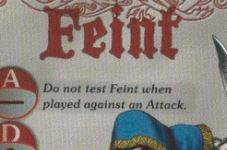Hi all,
I’m about to GM a game for a group who (including myself) have zero experience with Torchbearer.
I’ve managed to find (mostly on these forums) the answers to many questions I’ve had, but still have quite a few remaining, if anyone could set me straight on the following it would be greatly appreciated!
-
I’m looking forward to trying the conflict system, but it’s a new concept to understand…I’ve seen a post where Thor says to disregard what monsters/NPCs want when deciding what a conflict, it’s all about the PCs.
1a. What do I do if for example a raging band of orcs, frothing at the mouth, weapons drawn runs screaming at the party, and the PCs try to riddle with them? (That’s a very extreme example, but what I mean is how do I handle a mismatch in intents between sides when choosing a conflict type?)
1b. Do I pick the conflict type based on the PC actions and ignore the orcs behaviour?
1c. What if the answer to the above is that I should declare a riddle conflict, and then the homicidal orcs win, am I allowed to kill the players if they lose this non-kill conflict? -
What would I do if the PCs won a drive off conflict against some monsters who were in a dead-end with nowhere to flee to?
-
What do I do if the players want to kill some monsters whose immediate reaction to danger would be to flee?
3a. Should I declare a kill conflict and describe them fighting the PCs?
3b. If the monsters, who would like to flee, win the kill conflict do I describe them as having successfully fled or as having killed PCs? -
Barring special circumstances, can a conflict only kill pcs if it’s a kill conflict?
-
How do (hypothetical) parties without a cartographer navigate?
5a. How do you handle fast travel via a map if there’s an obstacle in the way?
5b. What do you do if your party starts making a habit of fast travelling out of the dungeon to camp, and then fast travelling back to where they were again to continue adventuring? -
Can Supplies be made in the adventure phase?
-
Can you fail a roll, log a failure, then reroll with Fate and potentially succeed?
-
Can a PC choose not to help a disposition roll?
8a. If so, can they avoid giving their Hungry&Thirsty penalty to the roll? -
You can’t use a trait against yourself in camp to earn a check, but can you use it to help log a failed test?
-
Cartography tests are to make maps, not use them, correct?
-
Besides fighting and exploring (adventure only) and recovery tests (camp only) are there any limits to the phase in which things can be done?
11a. e.g. Cartography can be done in either?
11b. Is the Survivalist test for a safer camp done in the adventure or camp phase?
I’ve seen Thor say creating scrolls can be done in the adventure phase. -
Can you use a check to make a recovery roll when entering town and then test recovery for the same condition in town?
-
Is there any reason, besides the fact that coins can be split up into 1D units, to sell loot first instead of trading it directly when purchasing something?
-
Does a -1s penalty always apply, regardless of whether a versus test was lost, tied, or won?
-
Do conflicts advance the grind by 1 when complete?
-
Can wises and traits be used in conflicts?
-
Can Heart of Battle, Wizard’s Sight, Touched by the Gods be used by players essentially as a +1D bonus once per session to Fighter, Arcanist, and Ritualist respectively?
-
How do Wises perks (if not changing a wise) work? Do I then roll a test for any skill I like (can I be helped?) and log a pass or fail (can I choose which to log?) or do I simply advance a skill?
Thanks!


